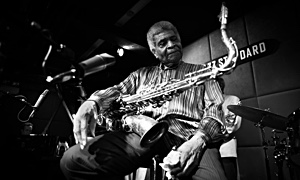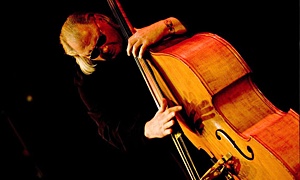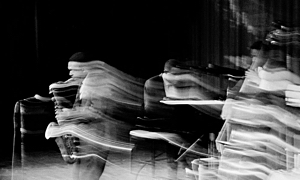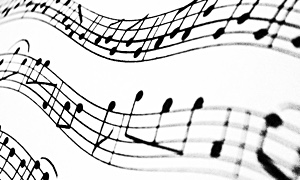Home » Jazz Articles » On and Off the Grid » Johnny Smith: The Man, The Legend
Johnny Smith: The Man, The Legend
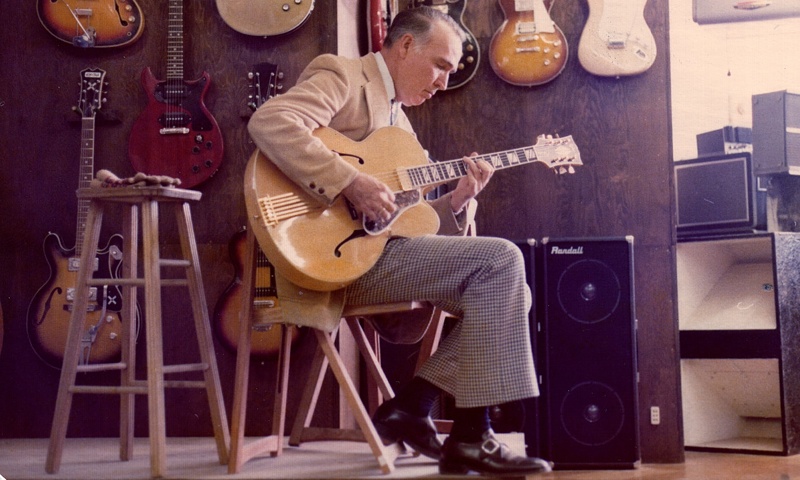
No matter how you cut it, Johnny Smith brought a level of excellence to guitar playing that will exist forever
—Dom Minasi
There will be many articles written about him. Besides the historical content of his accomplishments, I want to write about what he meant to me on a personal level and the thousands of other guitarists throughout the world.
I was 14 years old when I started attending John Adams High School in Ozone Park, New York. Adams was a large school and had over five thousand kids attending in different time shifts and had every type of activity you could think of. Today's specialized schools could not compare to the high schools of yesteryear. We had every type of sports team, every language and drama club you could think of. And then there was music. It had a junior chorus, senior chorus, acapella chorus, orchestra, marching band, and a big band (swing/jazz). Besides being on the football team, I joined the junior chorus. I took bass lessons at school so I could play in the orchestra and I played guitar in the swing band. As a sophomore, I was able to add music theory as one of my majors. A few years later I quit football because I was at a crossroads; play football or the guitar.
My days in the swing band were great. I made a lot of new musical friends (that I still have today) and I got to improve my reading skills—and I played music that I enjoyed. The swing band was so enthusiastic about playing, that we would sometimes have extra rehearsals at the drummer's house. The first time I went to Mike Simonetti's house, I was early. In fact I was the only one there. Mike showed me an album called Moonlight In Vermont, and asked if I had ever heard of Johnny Smith. I was new to jazz and I didn't know who a lot of the player's were. He put on the record and I sat there stunned. I had never heard a guitar played like that before. Besides an astounding technique, Johnny Smith's chordal work and sound was incredibly beautiful. The arrangements were extraordinary and I could tell they were very difficult to execute.
At that time I was studying guitar with Joe Genelli. Joe was a great teacher and a great player, and I asked him about Johnny Smith. Joe knew him and they were friends. As a kid this was just unbelievable to me. My teacher knew a jazz star! I later found out, because of Joe's extensive work, he knew all the greats at that time. Joe started giving me chord melodies to learn a la Johnny Smith's style. I was thrilled to learn them.
During the 1950s in New York City, The Daily News, and The New Post advertised all the clubs in the Friday papers. When I saw that Johnny Smith was playing at Birdland, I begged my father to take me to see him. We went on a Friday night and we sat at a table right up front. Johnny was only 35 at the time. He strapped on the guitar and began to play. I was truly amazed and I knew from that point on, that's what I wanted to do. I not only wanted to be a jazz musician, I wanted to have the kind of technique and control that Johnny had.
One of the first things I did was go out and buy a portable hi-fi set. That's what they called stereos in those days. Then I bought Moonlight In Vermont. I also realized that my time with Joe Genelli was up. If I wanted to grow as a guitarist I would have to find a real jazz guitarist to study. Although Joe was a jazz guitarist, his style was more like a swing player from the forties. His real strength was his ability to sight-read.
As I became more and more aware of jazz guitarists, I started to search for one to study with. Billy Taylor had a jazz TV Show on every Saturday that I watched like clock work. His guitarist was Mundell Lowe. I found his number and gave him a call. He told me he was too busy. I asked him who he thought I could study with, and he told me to try Sal Salvador. I found Sal's number and gave him a call. Sal didn't teach me anything about jazz or harmony and theory but he made me realize how much I didn't know about music or the guitar. Within one month with Sal I was improving as a guitarist.
Because Birdland had a peanut gallery for kids, I was able to go see Johnny Smith whenever he appeared there and because there were always two groups performing, I saw many other jazz musicians. That's when I realized there was more to this music than I had thought. I taught myself everything about jazz and harmony and theory because in those days it was a big secret. No one was giving it away. If you wanted to learn, you had to listen and basically teach yourself. But it all started with Johnny Smith.
Johnny's influence spread far and wide. Not only was he a super guitarist he was a great musician who could read anything at sight.
Johnny Smith was born on June 22nd 1922 in Birmingham, Alabama. His father played banjo but he was fascinated with the guitar. Because of the lack of guitar teachers, Johnny taught himself to play. When Johnny's family moved to Portland, Maine, he was 13 years old and good enough to play in local bands. In 1942 he joined the Air Force and ended up in the band, which needed a cornet player not a guitarist. Being a natural, Johnny became first cornettist within six months. After his discharge he went back to Portland and played again with the local bands and on the radio show, now doubling on guitar and cornet. The pay wasn't very good in Portland and Johnny decided to move to New York City.
In New York City, his talent was immediately recognized and he became staff guitarist for the NBC Orchestra and a working studio player. He made his first record as leader in March 1952 for Royal Roost Records, better know as Roost Records. The musicians for his first recording were Stan Getz, Eddie Safranski, Sanford Gold and Don Lamond. The title tune, "Moonlight in Vermont," was a turning point in his career. Most of his albums featured solo guitar or a trio; two backed Johnny with strings playing arrangements he wrote himself. During his tenure at Roost Records, he produced a long list of significant recordings that include the great quartet recordings: The Johnny Smith Quartet" and The Sound of The Johnny Smith Guitar, among others. In 1954 he wrote and recorded "Walk Don't Run" as a jazz piece. After hearing Chet Atkins recording of the song, the Ventures recorded it as a rock surf tune and since then many artists have recorded it. I personally owned every one of Johnny's records till I loaned them to a student and he and the records disappeared. Fortunately I have a friend who sent me all of Johnny's recording a few years ago and they are still a joy to listen to.
Johnny Smith retired from the jazz scene when his wife died giving birth to their daughter. Realizing a life on the road would not be conducive to being a father, Johnny moved to Denver, Colorado where he opened a music store and gave guitar lessons in the back. Although I had seen him play many times, I was so in awe of him, I never thought to introduce myself to him and the one regret I have is that I never really got to know him as some of my other guitar friends have.
Guitarist Mitch Seidman reminiscing about Johnny says: "I only met Johnny Smith once, but I will never forget the experience." I was visiting my sister in Boulder (It must have been in the early 1970s) and gave him a call to arrange for a lesson. I drove to his store in Colorado Springs, and walked in to see Johnny Smith behind the counter, patiently waiting on customers. I was flabbergasted, and wondered if they knew who he was? Johnny asked me to play some solo guitar for him, so I played an arrangement of a standard that utilized every harmonic technique I knew to date, making it a musical equivalent of including everything but the 'kitchen sink.' Johnny said something like, "You know what you're doing, and I think I know what you're doing, but no one else is going to know what song you are playing." He suggested that I first play the song more simply before re-harmonizing it as I had so that the audience can recognize it. We then played a couple of tunes together until he had to return to the store. It was a very valuable lesson, not to mention quite a thrill for me, and he would not take a dime in payment."
Guitarist Vic Juris recalls: "I played at a tribute concert to Johnny in the '90's with John Abercrombie. I remember meeting Johnny briefly and he recalled our first introduction at Fat Tuesdays in NYC a few years earlier. The Tony Mottola Recording Ensemble made a short speech at Johnny's memorial concert that was so beautiful and heartfelt. Johnny, to this day for me, had the most beautiful electric arch top sound I've ever heard."
He continued to play in local nightclubs and made a recording with some local musicians "Reminiscing," that showed he had lost none of the signature Johnny Smith style or technique. His last recorded work was the Concord Records album, Legends, in 1994.
Johnny Smith and His Guitars
In 1955, after discussions with the Guild Guitar Company, Smith designed a guitar and sent the drawings and specifications to the company. The Guild designers modified it (to Smith's dissatisfaction), and manufactured the resulting guitar as the Guild Johnny Smith Award.
In 1961, Gibson, went to meet the retired Smith at his home in Colorado Springs. Smith designed the guitar he wanted built. The design was accepted by Gibson with a few minor cosmetic changes which were acceptable to Smith. Gibson began production of the resulting Gibson Johnny Smith model that year. Guild continued to produce their Johnny Smith guitar under the model name Guild Artist Award. When Gibson moved its manufacturing facilities from Kalamazoo, Michigan to Nashville, Tennessee, several of their managers and artisans chose to stay behind. Many of these ex-employees formed Heritage Guitars and bought the old Kalamazoo factory from Gibson. Given a choice between Gibson and Heritage building the guitar that bore his name, Smith chose to stay with the old artisans at the old location under new ownership. The Heritage Johnny Smith model was introduced in 1989. Like Guild before them, Gibson continued to manufacture their version of the Johnny Smith design with a new name: the Gibson LeGrand.
Fender Musical Instruments Corporation, of which Guild Guitars was a subsidiary, asked Smith if he would be willing to return his endorsement to the Guild Artist Award. Familiar with Schultz's management, and knowing that the construction would be supervised by master luthier Bob Benedetto, Smith agreed. The Guild Johnny Smith Award by Benedetto was available through Guild dealers until early 2006 when Benedetto left Fender.
Johnny Smith's Approach To Chord Melodies
 "The hardest thing to do on the guitar is to play a melodic chord progression in smooth, even fashion without leaving space between chords," he told the Colorado Springs Independent. "Then one day I noticed how an organist managed to keep a tone going between chords by holding down one of the notes of the chord while he pivoted to the next chord. I picked up on that and applied it to chord progressions on the guitar." There are some players out there who claim Johnny wasn't a real jazz guitarist. There was a point in my life that I felt the same way. He didn't swing the way Wes Montgomery did, or had a deep bluesy feeling like Kenny Burrell or Grant Green, but as I go back every so often and listen to him, I can hear the beauty in his playing and that has it's own kind of soul. And every so often when he stops playing scales and arpeggios, he plays single lines that are loose and swing.
"The hardest thing to do on the guitar is to play a melodic chord progression in smooth, even fashion without leaving space between chords," he told the Colorado Springs Independent. "Then one day I noticed how an organist managed to keep a tone going between chords by holding down one of the notes of the chord while he pivoted to the next chord. I picked up on that and applied it to chord progressions on the guitar." There are some players out there who claim Johnny wasn't a real jazz guitarist. There was a point in my life that I felt the same way. He didn't swing the way Wes Montgomery did, or had a deep bluesy feeling like Kenny Burrell or Grant Green, but as I go back every so often and listen to him, I can hear the beauty in his playing and that has it's own kind of soul. And every so often when he stops playing scales and arpeggios, he plays single lines that are loose and swing. For those of you who are interested in hearing his work, Mosaic Records put out a box set of his recordings a few years ago called, The Complete Roost Johnny Smith Small Group Session.
No matter how you cut it, Johnny Smith brought a level of excellence to guitar playing that will exist forever. And for that, I will be eternally grateful to him.
< Previous
Trios
Next >
Barranquijazz 2013
Comments
Tags
Johnny Smith
On and Off the Grid
Dom Minasi
United States
New York City
Birdland
Billy Taylor
Mundell Lowe
Sal Salvador
Stan Getz
Eddie Safranski
Sanford Gold
Don Lamond
Chet Atkins
Mitch Seidman
Vic Juris
John Abercrombie
Tony Mottola
Nashville
Wes Montgomery
Kenny Burrell
Grant Green
Mosaic Records
For the Love of Jazz
 All About Jazz has been a pillar of jazz since 1995, championing it as an art form and, more importantly, supporting the musicians who create it. Our enduring commitment has made "AAJ" one of the most culturally important websites of its kind, read by hundreds of thousands of fans, musicians and industry figures every month.
All About Jazz has been a pillar of jazz since 1995, championing it as an art form and, more importantly, supporting the musicians who create it. Our enduring commitment has made "AAJ" one of the most culturally important websites of its kind, read by hundreds of thousands of fans, musicians and industry figures every month.






